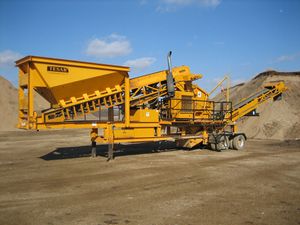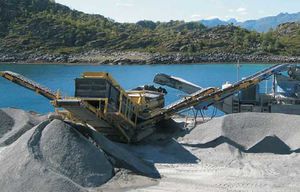Difference between revisions of "Crushers"
| Line 18: | Line 18: | ||
==stages== | |||
For the purpose of mineral extraction when ore is excavated from earth the size of run of-mine ore can vary a lot between fines powders to big boulders of 1.5 m across. Moreover the feed can also be intermittent type in the form of dumpers feeding the crushing plant. The crusher at this stage is called primary crusher the main purpose of which is to give continuous feed to the plant down the line in a size convenient for further handling in the process plant. In the next stage further crushing may be required so as to ensure proper releasing of mineral from gangue. The crusher in this stage is called | |||
secondary crusher. | |||
There can be also another stage of crushing called tertiary crushing depending on the initial size of the run of mine ore and the final product size requirement. Different stages are required as total size reduction in one single crusher is not possible efficiently. Moreover smaller sizes of material tend to jam the flow of ore in the crusher and unless there is sufficient space for the crushed ore to expand in volume there will be choking of the crusher. Hence vibrating screens are deployed in between different stages of the crushers so that only those oversize ore can be fed to the crusher whose sizes need to be reduced. This also helps in reducing the capacity requirement of the crusher as total run of mine ore need not be fed to the crusher. Also there will be closed circuit operation in case of secondary and tertiary crushers so as to avoid passing of any oversize material to the final stage. Primary crushing is done in open circuit only. | |||
Revision as of 07:42, 31 January 2012
A crusher is a machine designed to reduce large rocks into smaller rocks, gravel, or rock dust. Crushers may be used to reduce the size, or change the form, of waste materials so they can be more easily disposed of or recycled, or to reduce the size of a solid mix of raw materials (as in rock ore), so that pieces of different composition can be differentiated. Crushing is the process of transferring a force amplified by mechanical advantage through a material made of molecules that bond together more strongly, and resist deformation more, than those in the material being crushed do. Crushing devices hold material between two parallel or tangent solid surfaces, and apply sufficient force to bring the surfaces together to generate enough energy within the material being crushed so that its molecules separate from (fracturing), or change alignment in relation to (deformation), each other. The earliest crushers were hand-held stones, where the weight of the stone provided a boost to muscle power, used against a stone anvil. Querns and mortar and mortars are types of these crushing devices.
Industrial use
In industry, crushers are machines which use a metal surface to break or compress materials. Mining operations use crushers, commonly classified by the degree to which they fragment the starting material, with primary and secondary crushers handling coarse materials, and tertiary and quaternary crushers reducing ore particles to finer gradations. Each crusher is designed to work with a certain maximum size of raw material, and often delivers its output to a screening machine which sorts and directs the product for further processing. Typically, crushing stages are followed by milling stages if the materials need to be further reduced. Crushers are used to reduce particle size enough so that the material can be processed into finer particles in a grinder. A typical circuit at a mine might consist of a crusher followed by a grinder SAG mill followed by a grinder ball mill. In this context, the SAG mill and ball mill are considered grinders rather than crushers.
stages
For the purpose of mineral extraction when ore is excavated from earth the size of run of-mine ore can vary a lot between fines powders to big boulders of 1.5 m across. Moreover the feed can also be intermittent type in the form of dumpers feeding the crushing plant. The crusher at this stage is called primary crusher the main purpose of which is to give continuous feed to the plant down the line in a size convenient for further handling in the process plant. In the next stage further crushing may be required so as to ensure proper releasing of mineral from gangue. The crusher in this stage is called secondary crusher.
There can be also another stage of crushing called tertiary crushing depending on the initial size of the run of mine ore and the final product size requirement. Different stages are required as total size reduction in one single crusher is not possible efficiently. Moreover smaller sizes of material tend to jam the flow of ore in the crusher and unless there is sufficient space for the crushed ore to expand in volume there will be choking of the crusher. Hence vibrating screens are deployed in between different stages of the crushers so that only those oversize ore can be fed to the crusher whose sizes need to be reduced. This also helps in reducing the capacity requirement of the crusher as total run of mine ore need not be fed to the crusher. Also there will be closed circuit operation in case of secondary and tertiary crushers so as to avoid passing of any oversize material to the final stage. Primary crushing is done in open circuit only.
Some crushers are mobile and can crush rocks (as large as 60 inches). Primarily used in-pit at the mine face these units are able to move with the large infeed machines (mainly shovels)to increase the tonnage produced. In a mobile road operation, these crushed rocks are directly combined with concrete and asphalt which are then deposited on to a road surface. This removes the need for hauling over-sized material to a stationary crusher and then back to the road surface.
Technology
For the most part advances in crusher design have moved slowly. Jaw crushers have remained virtually unchanged for sixty years. More reliability and higher production have been added to basic cone crusher designs that have also remained largely unchanged. Increases in rotating speed, have provided the largest variation. For instance, a 48 inch (120 cm) cone crusher manufactured in 1960 may be able to produce 170 tons/h of crushed rock, whereas the same size cone manufactured today may produce 300 tons/h. These production improvements come from speed increases and better crushing chamber designs.

